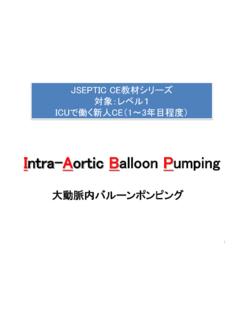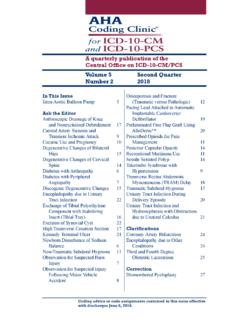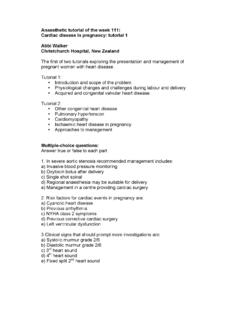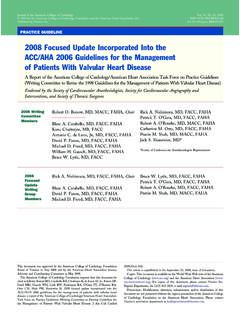Transcription of ANAESTHESIA TUTORIAL OF THE WEEK 220 - FRCA
1 Sign up to receive ATOTW weekly - email ATOTW 220 Intra- aortic balloon Pump Counterpulsation 25/04/2011 Page 1 of 8 INTRA- aortic balloon PUMP COUNTERPULSATION ANAESTHESIA TUTORIAL OF THE week 220 25TH APRIL 2011 Dr Bashir Alaour, Dr William English, Royal Cornwall Hospitals NHS Trust, UK Correspondence: INTRODUCTION The intra- aortic balloon pump (IABP) is a temporary coronary and systemic perfusion assist device. Since introduction into clinical practice in the 1960s it has become widely used in critically ill patients with coronary disease and cardiac pump failure. This article will review the basic principles underlying IABP counterpulsation, the device s indications, contraindications, techniques for insertion and operat-ing instructions. Understanding the basic principles, physiological effects, appropriate set-up and po-tential complications of the IABP are essential for improving patient outcomes.
2 BASIC PRINCIPLES AND PHYSIOLOGICAL EFFECTS Synchronized counterpulsation is the core principle of IABP therapy. This describes inflation in diasto-le and deflation in systole of a balloon situated in the descending aorta. The overall aim is to improve myocardial function by increasing myocardial oxygen supply and decreasing myocardial oxygen de-mand. The method by which this is achieved is by displacement of blood in the aorta, both proximally and distally during balloon inflation. Figure 1 illustrates schematically how this is achieved. Figure1. Physiological effects of IABP Sign up to receive ATOTW weekly - email ATOTW 220 Intra- aortic balloon Pump Counterpulsation 25/04/2011 Page 2 of 8 balloon inflation occurs at the start of diastole. This displaces blood proximally and provides increased coronary blood flow by increasing aortic root diastolic pressure.
3 This results in forcible active filling of the coronary arteries. This is in contrast to coronary artery filling in normal circumstances that is an autoregulated, passive process. Blood in the descending aorta is also displaced distally during balloon inflation. This may provide improved blood flow in the coeliac, renal and mesenteric vessels. However the significant improvement in systemic perfusion that is seen with successful use of an IABP is pre-dominantly due to the reduction of afterload that occurs with rapid balloon deflation at the start of sys-tole. This reduction in afterload results in a decrease in the workload of the left ventricle and a decrease in myocardial oxygen consumption. The overall effect of an improved ratio of myocardial oxygen sup-ply to myocardial oxygen demand is improved myocardial performance.
4 The magnitude of the effects of IABP counterpulsation on systemic and coronary haemodynamics de-pends on a number of factors. These include the relationship of balloon volume to aortic size, aortic compliance, heart rate and heart Overall, IABP counterpulsation is expected to increase dias-tolic pressure by 30% (ideally to a value greater than systolic pressure), decrease the systolic pressure by 20% and improve cardiac output by 20%.2 However the most appropriate way of assessing the ade-quacy of IABP therapy is by repeated assessment of the adequacy of systemic and coronary circulation through regular patient examination and assessment of clinical and laboratory parameters. INDICATIONS Since its introduction in the 1960s there has been a considerable increase in the indications for IABP use.
5 Current indications for IABP are shown below. Indications have been divided into those with clear evidence of benefit, those with probable benefit and those with no evidence to suggest benefit. Indications with proven benefit Cardiogenic shock secondary to AMI refractory to medical therapy 3 Mechanical complications of AMI: acute MR and VSD Refractory ventricular arrhythmias 4 Refractory unstable angina 5 Decompensated systolic heart failure (as a bridge to definitive treatment) Indications with probable benefit Peri-operative support for high risk coronary artery bypass surgery6 Peri-operative support for high risk cardiac patients undergoing non-cardiac surgery Decompensated aortic stenosis 1 Indications with no evidence to suggest benefit Sepsis Routine use in high-risk patients undergoing PCI 7 AMI acute myocardial infarction, MR mitral regurgitation, VSD entricular septal defect, PCI percutaneous coronary intervention Contrary to the results and recommendations of several small observational studies, one large random-ised controlled trial found that elective IABP insertion before high risk PCI adds no significant benefit in reducing the incidence of major adverse cardiovascular and cerebral events at 4 weeks 7.
6 Routine IABP therapy in high risk patients undergoing PCI is not recommended and should be preserved to patients who are unstable or likely to become unstable during PCI. Sign up to receive ATOTW weekly - email ATOTW 220 Intra- aortic balloon Pump Counterpulsation 25/04/2011 Page 3 of 8 CONTRAINDICATIONS The contraindications to IABP are summarised in below. Absolute Significant aortic regurgitation and aortic dissection aortic stent End-stage cardiac disease with no viable other treatment options Bilateral femoral-popliteal bypass grafts (femoral route only contraindicated) Relative Uncontrolled sepsis Abdominal aortic aneurysm Severe bilateral peripheral vascular disease Uncontrolled bleeding disorder Prosthetic ileo-femoral grafts/iliac artery stents COMPLICATIONS The Benchmark Counterpulsation Outcomes Registry published data on nearly 1,700 patients who un-derwent IABP therapy between 1996 and 2000 5.
7 In this series of patients experienced one or more major complications (defined as death, major limb ischaemia, severe bleeding or balloon leak). The incidence of minor complications was The most common complications of IABP therapy are related to the presence of the IABP catheter it-self and the technique used for insertion. Rapid inflation and deflation of the balloon causes trauma to red blood cells and platelets, commonly resulting in anaemia and/or thrombocytopenia. Device related thrombus formation and subsequent embolization are also significant risks. Because of these factors, patients with an IABP in situ are usually systemically anticoagulated, resulting in an increased risk of bleeding at the insertion site. The most common vascular complication is limb ischaemia, noting that many patients in whom IABP therapy is indicated in will have either established peripheral arterial disease or multiple risk factors.
8 All patients must therefore have their peripheral pulses, capillary return and skin temperature moni-tored on at least an hourly basis whilst an IABP catheter is in situ. Unresolved limb ischaemia may require removal of the device and urgent vascular surgery review if ischaemia persists. balloon rupture is a rare complication. It can be indicated by a sudden loss of inflation pressure or the presence of blood in the balloon line and is associated with a risk of intra- balloon thrombus and helium embolisation. If balloon rupture occurs the console will alarm and withdraw helium from the balloon before shutting down. Surgical removal of the balloon may be required to ensure complete removal. Sign up to receive ATOTW weekly - email ATOTW 220 Intra- aortic balloon Pump Counterpulsation 25/04/2011 Page 4 of 8 The complications of IABP are shown below.
9 Vascular Limb ischaemia Vascular laceration and local vascular injury at time of insertion aortic dissection Spinal cord and visceral ischaemia Peripheral thrombotic embolization False aneurysm and AV fistula formation balloon related Misplacement or migration of the balloon (may lead to occlusion of renal or subclavian arter-ies or perforation of the aortic arch) balloon perforation or rupture leading to gas embolization Thrombocytopenia Anaemia Miscellaneous Infection TECHNIQUES OF INSERTION AND OPERATION Device insertion IABP catheters are supplied with an instruction booklet that should be reviewed before use. The size of the balloon is selected based on the patient s height. The usual range for an adult patient is between 25cc (for patients under 5 feet tall) to 50cc (for patients over 6 feet tall) but individual manufacturer s guidance should be followed.
10 The IABP is usually inserted percutaneously using the Seldinger tech-nique and strict aseptic technique. The most common site of access is the femoral artery. Alternative access sites include brachial and axillary artery percutaneous techniques and open surgical aortic ap-proach. After successful puncture of the chosen artery a J-shaped guide wire is inserted to the level of the aortic arch. A combined dilator and sheath combination is then inserted, allowing the balloon to then be fed over the guide wire into the descending aorta, usually under fluoroscopic guidance. The tip of the IABP catheter should lie 1 2 centimetres distal to the origin of the left subclavian artery. This corresponds to the level of the second rib. Alternative methods for guiding IABP catheter placement include transoesophageal echocardiography or open sheathless insertion during cardiac surgery.
















